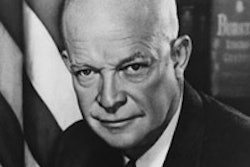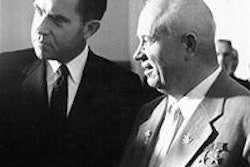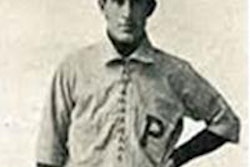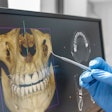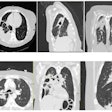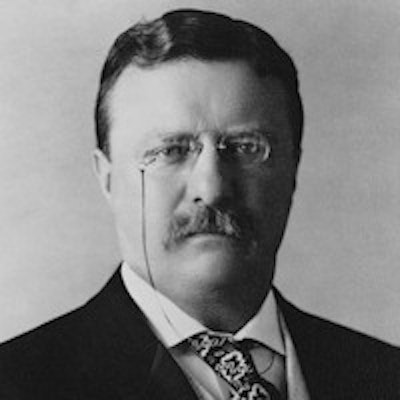
In 1918, an elderly women suffering from dementia attended a church program featuring former President Theodore Rex Roosevelt. Pointing at Roosevelt, she asked the usher if "that there man" was going to speak.
"What man?" the usher asked. "I can't remember his name," the old woman replied, "but it's the chap I always thought would make a good advertisement for a dentist. He's got wonderful teeth, and always shows them."
About the same time a story circulated throughout the nation's newspapers about a teacher who told the story of Little Red Riding Hood to her class. In recounting "the woods and wild animals that flourished therein," she added: "Suddenly, Red Riding Hood heard a great noise. She turned about and what do you suppose she saw standing there, gazing at her and showing all its sharp, white teeth?"
"Teddy Roosevelt!" one boy volunteered.
Even a toothy smiling Aztec figurine unearthed in Mexico City in 1916 was likened to the ex-president. A Chicago newspaper claimed the figurine was "an Aztec deity and in its day was worshipped pretty much as thousands of this country now worship our own Teddy."
 Theodore Roosevelt (1858-1919).
Theodore Roosevelt (1858-1919).
Theodore ("TR" or "Teddy") was known as the first smiling president. He was often photographed or illustrated "grinning from ear to ear." According to Arden Christen, professor emeritus of Indiana University School of Dentistry, "His flashing white teeth, wide smile, and engaging openness became welcome symbols of national and international acceptance." He was born with near perfect teeth that protruded in a broad, friendly smile, which became his symbol. One scholar referred to his teeth as "ferocious." Unlike prior presidents (many of whom had bad teeth), Roosevelt's were near perfect, and he used them to his advantage.
Cartoonists relished his presidency because his teeth were so identifiable. One of them, E. W. Kemble of Harper's Weekly, delighted in portraying Roosevelt "grinning toothily," according to the historian Edmund Morris, the author of several books on Roosevelt. Examples of other descriptive phrases recited in Morris' book Colonel Roosevelt include "white tile grin," "click of his teeth," "tooth-snapping vigor," and "highly specialized smile" -- the latter being "disarming," according to Morris. Julian Street, a reporter for Collier's magazine wrote that Roosevelt "[charmingly] showed his hard white teeth" when Street first met the former president. Sonya Levien, an editor at Metropolitan magazine who worked with TR, claimed his smile was "an arc of light" that had a "magnetic sparkle."
'Grief-stricken beyond despair'
Roosevelt was born in New York City in 1858. As a youth, he suffered from severe asthma and diarrhea. His doctors did not expect him to live beyond the age of 3. At the time, common therapeutic agents and antibiotics of our era had not been developed. His doctors described him as having "skinny legs, eager blue eyes, sandy hair, and protruding teeth." His father often "walked the floor with him to try to help him breathe," Robert Kimberly of the Theodore Roosevelt Association wrote. His father encouraged him to build his body using weights, boxing, and spending considerable time outdoors in the fresh air. Eventually, according to Kimberly, he overcame "his infirmities and [became] the rugged outdoorsman we know."
Roosevelt attended Harvard College, graduating magna cum laude in 1880. Because of his asthma and a bout with cholera, doctors there advised him to "lead [a] sedentary, scholarly life because of [his] heart weakness." At Harvard, he studied zoology and was a champion collegiate boxer. He had a photographic memory and while a student at Harvard published articles on ornithology (the study of birds).
Roosevelt married Alice Lee in 1880. Shortly after his graduation, he published The Naval War of 1812, which established him as a major historian. The scholarly study continues to "influence all subsequent scholarship on the naval aspects of the war," according to Michael Crawford, a current expert on Roosevelt.
In 1881, a year after graduating from Harvard, he was elected to the New York State Assembly. Two years later, on Valentine's Day, his mother died of typhoid fever; 11 hours later his wife died of kidney failure. She had given birth to their first child, Alice, two days earlier.
Grief-stricken beyond despair, the 26-year-old Roosevelt quit the Legislature, placed his daughter in the care of his sister, and moved to the Dakota badlands, where he spent the next two years developing ranching properties in North Dakota. At the same time, he published three books on ranching and hunting, along with writing numerous articles about frontier life for Eastern magazines.
During his lifetime, the scholarly Roosevelt would author 35 books, thousands of articles, and more than 150,000 letters. Throughout his adult life, he was the ultimate multitasker, capable of reading a book and dictating a letter to a stenographer and a memo to a secretary all at the same time. He was a speed reader who read a book every day before breakfast and, time permitting, two or three more in the evening after a full day of work. According to one report, "by his own estimates, TR read tens of thousands of books during his lifetime, including hundreds in foreign languages." He was multilingual with a command of French, German, and Italian. He also mastered Classical Greek and Latin. In 1886, he married his second wife Edith Callow, a childhood sweetheart. Together the couple had five children.
Roosevelt's organizational achievements were Herculean. He was instrumental in the founding of the National Collegiate Athletic Association and served as president of the American Historical Association. He was an ardent naturalist and conservationist who spearheaded legislation establishing the U.S. Forest Service and setting aside more than 230 million acres of national parkland, monuments (including the Grand Canyon), bird sanctuaries, and game reserves. During his lifetime, he was considered the world's authority on large American mammals.
Youngest president ever
The multifaceted Roosevelt was also a war hero, leading cavalry charges in Cuba during the Spanish-American War. Besides serving in the New York Legislature, he also served as New York City police commissioner, civil service commissioner, assistant secretary of the U. S. Navy, governor of New York, vice president of the U.S., and, upon the assassination of President William McKinley, ascended to the presidency at the age of 42 -- the youngest president ever.
His effervescent personality and energy were broadcast across U.S. newspapers, magazines, and early cinematic newsreels. As president, he brokered a peace treaty in the war between Russia and Japan in 1904, winning him the Nobel Peace Prize -- the first ever awarded to an American (the Nobel Prizes were established in 1901). He was the first president to entertain a black American (Booker T. Washington) in the White House. He acquired the Panama Canal Zone, enabling the U.S. to construct the canal the linked the Atlantic and Pacific Oceans. Preaching his "Square Deal" for Americans, he busted the large commercial trusts that had economically enslaved the average U.S. worker. Additionally, he secured laws that regulated the railroads and forced inspection of the meat industry, as well as signed the Pure Food and Drug Act for consumer protection.
Roosevelt led two major scientific expeditions, one on behalf of the Smithsonian Institute to equatorial Africa, where he collected animal and flora specimens. Shortly after his presidency, he led another expedition that explored and mapped a mysterious Brazilian River (Rio Dúvida, now known as the Rio Roosevelt) on behalf of the American Museum of Natural History and the Brazilian National Geographic Society. He was also the first president to fly in an airplane.
Lifetime of ailments
During his lifetime, Roosevelt was portrayed as a rugged individual, constantly on the go, a man of gusto, tireless energy, enthusiasm, and zeal. In reality, besides his childhood asthmatic health problems, he experienced significant health problems throughout his life. During the Spanish-American War, he contracted malaria, which frequently reoccurred until he died. During his Brazilian expedition, he nearly died from the disease and infection, losing more than 50 pounds. He had to be carried by porters, "weak and ravaged by sickness."
Roosevelt died in January of 1919 at the age of 60. An article by A.M. Jungmann in Ladies Home Journal published in April of that year alleged that his death was caused by an infected tooth. Jungmann wrote, "Those flashing white teeth won him millions of friends -- yet one of those teeth killed him." Jungmann speculated that a root canal 20 years earlier had remained septic, which was the root cause of many of his illnesses and ultimately his death. Jungmann's speculation, before the advent of antibiotics, may well have been correct. Christen, in his article about Roosevelt's dental health, validates this early 20th century notion, writing, "there was a widespread belief that 'a bad tooth' that had previously been edodontically treated was the probable cause of death."
However, modern medical diagnostics pretty much discounts this belief. Morris, in his book, notes that Roosevelt's body was indeed rampant with "Cuban and Amazonian pathogens," but that the real cause of his death was a heart attack caused by hardened arteries and probably a blood vessel blockage (myocardial infarction, secondary to chronic arthrosclerosis and with possible acute coronary occlusion). His death was likely brought on by a lifelong compulsive eating disorder.
In fact, Roosevelt referred to himself as an "abnormal eater." It was not unusual for him to consume 12 eggs for breakfast along with potatoes, toast, and large quantities of breakfast meats. According to Morris, his daughter Ethel "was amazed at the amount of lunch he could put away," noting on one occasion that "he had 2 plates of tomatoes, 2 plates of applesauce, 1 plate of potato, grouped around ... spare ribs of pork." She counted "18 which he ate and then he refused to let me count further!!"
Roosevelt was as big in death as in life. The New York Evening Post obituary referred to him as "a superman in the political sphere." A friend wrote, "The strongest character in the world has died." The sculptor Gutzon Borglum memorialized him best by including him in his Mount Rushmore bas-relief alongside the three other U.S. presidential "greats": Washington, Jefferson, and Lincoln.
And, of course, the teddy bear is a poignant reminder of his humanity. On a 1902 hunting expedition in Mississippi, he refused to shoot a black bear that had been hunted by hounds, clubbed, and tied to a willow tree with the expectation that Roosevelt would shoot and "bag" the animal. A disgusted Roosevelt refused, deeming it unsportsman-like -- and inspiring a toy manufacturer to invent and market the cute cuddly "Teddy" bears we know and love today.
Daniel Demers is a semiretired businessman whose hobby is researching and writing about 19th and 20th century historical events and personalities. He holds a bachelor's degree in history from George Washington University and a master's degree in business from Chapman University. You can review his other published works at www.danieldemers.com.
For a list of references for this article, click here.




